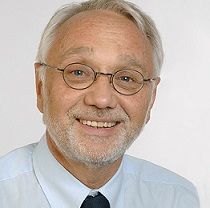Combination Therapy Shows Survival Benefit in EGFR T790M-Mutant NSCLC
Frontline combination treatment with erlotinib and bevacizumab demonstrated high efficacy in patients with advanced non-small cell lung cancer who harbored an EGFR T790M mutation.
Rolf A. Stahel, MD

Rolf A. Stahel, MD
Frontline combination treatment with erlotinib and bevacizumab demonstrated high efficacy in patients with advanced nonsmall cell lung cancer (NSCLC) who harbored anEGFRT790Mmutation, according to findings presented at the 2015 European Cancer Congress.1
“The combination of erlotinib and bevacizumab resulted in a one-year PFS rate of 72% in patients with documentedT790Mmutation and reached our predefined endpoint for success,” explained lead author Rolf A. Stahel, MD, Department of Oncology, University Hospital in Zurich, Switzerland, and current president of ESMO.
The 1-year PFS rate was 49.4% for those who received the combination and wereEGFR-mutant but did not have theT790Malteration (95% CI, 33.6-66.6). Median PFS was 16 months in T709M-positive arm (95% CI, 13.1-NE) and 10.5 months withoutT709M(95% CI, 9.2-16.2).
Stahel noted that theEGFRT790Mgatekeeper mutation is considered to be the main mechanism of acquired resistance to EGFR TKIs but can also be detected prior to treatment. While conventional DNA sequencing can detect pretreatment T790Min 1% to 8% of tumors, the PCR-PNA assay used in this study improves detection rates to between 35% and 65%.
In the open-label, phase II BELIEF trial, the combination of the angiogenesis inhibitor bevacizumab and the EGFR TKI erlotinib was explored in 109 patients with metastatic or locally advanced, nonsquamous NSCLC who were not candidates for radical surgery or radiotherapy. Patients had measurable disease and centrally confirmed activatingEGFRmutations (exon 19 deletion or L858Rmutations. All patients were treated with intravenous bevacizumab at 15 mg/kg on day 1 of each 3-week cycle, and oral erlotinib at 150 mg daily.
PretreatmentT790Mmutations were centrally identified based upon laser microdissection and TaqMan assay, using DNA from T790M-positive cells as a positive control and DNA from PC9 cells, which harborT790Mmutation at an allele frequency of 0.004%, as a negative control. Using this measure, 37 patients tested positive for the T790Malteration while 72 were negative. Each mutational group was treated in separate substudies.
The median age of patients withT790M-mutated NSCLC was 67 years, 63% were female, 70% were never smokers, and 97% had ECOG PS 0 to 1. Patients without the alteration were a median age of 63 years, 59% were female, 61% never smokers, and 90% had ECOG PS 0 to 1. At a median follow-up of 12 months, 47 patients remained on treatment (27 with aT790Mmutation and 20 without).
The median duration of response (DoR) was not evaluable (95% CI, 14.7-NE) versus 12.0 months (95% CI, 8.2-23.3), for theT790M-positive and -negative groups, respectively. The objective response rate (ORR) in those with theT790Malteration was 70.3% versus 79.2% in the negative group.
Complete response was observed in 8.1% of patients in theT790M-positive group and 5.6% in the negative arm. Partial response was seen in 62.2% versus 73.6% and stable disease was achieved by 23.4% versus 12.5%, in the positive and negative arms, respectively. Progressive disease occurred in none of the patients withT790M-positive disease compared with 4.2% of those with negative tumors.
The safety profile of the combination was consistent with that of each agent; no unexpected toxicities were identified. At least one serious adverse event (SAE) was reported in 16 patients in theT790M-positive group and in 11 patients withT790M-negative disease. The most commonly reported SAE’s in the positive group were each reported by two patients and included pancreatitis, confusion, and dehydration. Three patients in the negative group reported a thromboembolic event.
At the conference, lung cancer expert Martin Reck MD, Chief Oncology Physician in the Department of Thoracic Oncology, Hospital Grosshansdorf, Germany, toldTargeted Oncologythat VEGF inhibition by bevacizumab may delay resistance related to T790Mmutation and could be beneficial in the presence of this mutation. He noted that characterization of the molecular patterns of resistance following erlotinib/bevacizumab would also be an important issue.
“While these results are very promising, they perhaps will not be directly practice-changing,” Reck said. “Randomized confirmation, such as, by the RELAY trial of erlotininb/ramucirumab versus erlotinib/placebo in patients with NSCLC andEGFRmutation, is important in the decision to change standard treatment in this setting.”
In the randomized phase III RELAY trial, patients with untreatedEGFR-mutant NSCLC will receive either the VEGFR2 inhibitor ramucirumab combined with erlotinib or erlotinib alone. However, this study is excluding those with a knownEGFRT790Malteration. Recruitment in this study is ongoing, with a goal of enrolling 462 participants (NCT02411448).
In a previous randomized trial, patients received erlotinib plus bevacizumab or erlotinib alone as a first-line treatment for advancedEGFR-mutant NSCLC.2In this 154-patient study, the median PFS with the combination was 16 months compared with 9.7 months with single-agent erlotinib (HR, 0.54; 95% CI, 0.36-0.79;P= .0015). The ORR with the combination was 69% versus 64% with single-agent erlotinib.
References
- Stahel RA, Dafni U, Gautschi O, et al. A phase II trial of erlotinib (E) and bevacizumab (B) in patients with advanced non-small-cell lung cancer (NSCLC) with activating epidermal growth factor receptor (EGFR) mutations with and without T790M mutation. The Spanish Lung Cancer Group (SLCG) and the European Thoracic Oncology Platform (ETOP) BELIEF trial. Presented at: 2015 European Cancer Congress; September 25-29; Vienna, Austria. Abstract 3BA.
- Seto T, Kato T, Nishio M, et al. Erlotinib alone or with bevacizumab as first-line therapy in patients with advanced non-squamous non-small-cell lung cancer harbouring EGFR mutations (JO25567): an open-label, randomised, multicentre, phase 2 study.Lancet Oncol. 2014;15(11):12361244.